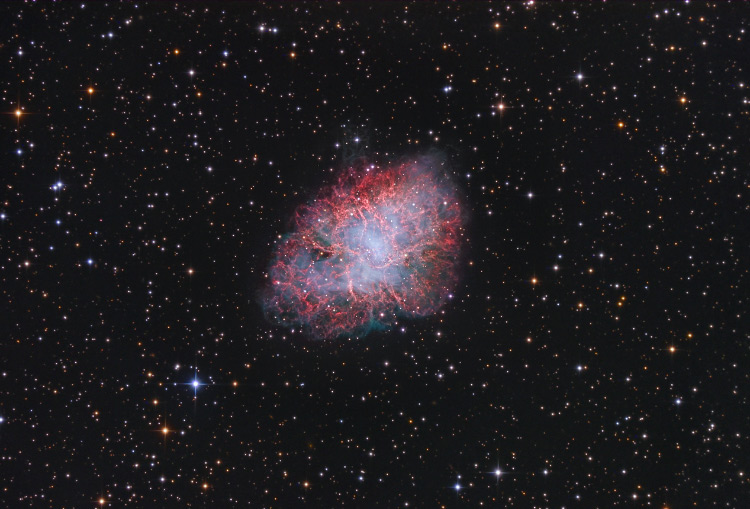|
The Crab Nebula is the most famous and conspicuous known supernova remnant, the expanding cloud of gas created in the explosion of a star as supernova which was observed on July 4, 1054 A.D. by Chinese astronomers as a new or "guest star," and was about four times brighter than Venus, or about mag -6.
According to the records, it was visible in daylight for 23 days, and 653 days to the naked eye in the night sky. It shines as a nebula of magnitude 8.4 near the southern "horn" of Taurus, the Bull.
The nebula consists of the material ejected in the supernova explosion, which has been spread over a volume approximately 10 light years in diameter, and is still expanding at the very high velocity of about 1,800 km/sec. The structure of this nebula is dominated by gaseous filaments, reddish component which form a chaotic web of bright filaments, which have an emission line spectrum (including hydrogene lines) like that of diffuse gaseous (or planetary) nebulae, and by a continuum background. The filaments are apparently the remnants from the former outer layers of the former star (the "pre-supernova" or supernova "progenitor"), while the inner, blueish nebula emits continuous light consisting of highly polarised so-called synchrotron radiation, which is emitted by high-energy (fast moving) electrons in a strong magnetic field.
In 1921, C.O. Lampland of Lowell Observatory, when comparing excellent photographs of the nebula obtained with their 42-inch reflector, found notable motions and changes, also in brightness, of individual components of the nebula, including dramatic changes of some patches near the central pair of stars (Lampland 1921). The same year, J.C. Duncan of Mt. Wilson Observatory compared photographic plates taken 11.5 years apart, and found that the Crab Nebula was expanding at an average of about 0.2" per year; backtracing of this motion showed that this expansion must have begun about 900 years ago (Duncan 1921). The actual 1054 occurrance of the supernova shows that the expansion must have been accelerated.
On November 9, 1968, a pulsating radio source, the Crab Pulsar was discovered in M1 by astronomers of the Arecibo Observatory 300-meter radio telescope in Puerto Rico. This pulsar was the first one which was also verified in the optical part of the spectrum, it is flashing at the same period of 33.085 milliseconds as the radio pulsar with the 90-cm (36-inch) telescope on Kitt peak. This optical pulsar is sometimes also referred to by the supernova's variable star designation, CM Tauri. It has now been established that this pulsar is a rapidly rotating neutron star: It rotates about 30 times per second! This period is very well investigated because the neutron star emits pulses in virtually every part of the electromagnetic spectrum, from a "hot spot" on its surface. The neutron star is an extremely dense object, denser than an atomic nucleus, concentrating more than one solar mass in a volume of 30 kilometers across. Its rotation is slowly decelerating by magnetic interaction with the nebula; this is now a major energy source which makes the nebula shining; as stated above, this energy source is 100,000 times more energetic than our sun.
North is up.
Find more info about M 1:
Hubble image of the center.
Hubble mosaic of M1.
Chandra-Hubble-Spitzer mosaic of M1.
ESO image of M1>
Find an animation showing the rapid expansion within the latest 7 years here.
Below you find a crop on the center of the above image in 50/100% size showing traces of a faint "jet" emanating to the north of the nebula.
|
